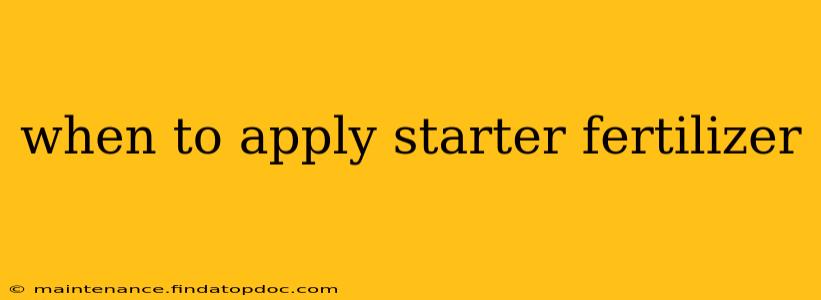Starter fertilizer provides young plants with the essential nutrients they need to establish strong root systems and healthy growth during their crucial early stages. Knowing precisely when to apply it is key to maximizing its benefits and ensuring your plants thrive. This guide will cover the optimal timing, application methods, and considerations for different plant types.
What is Starter Fertilizer?
Starter fertilizer is a concentrated blend of nutrients, typically higher in phosphorus (P) and potassium (K) than nitrogen (N). Phosphorus promotes robust root development, while potassium aids in disease resistance and overall plant vigor. The higher P and K levels help young plants overcome the initial stress of transplanting and establish themselves quickly. Nitrogen, while essential, is often less crucial in the early stages as it primarily promotes leafy growth. Over-application of nitrogen early on can actually hinder root development.
When Should You Apply Starter Fertilizer?
The best time to apply starter fertilizer depends primarily on the planting method:
For Seedlings: Apply starter fertilizer at the time of planting. For seeds sown directly into the ground, incorporate it into the soil before sowing. This ensures the nutrients are readily available as the seedlings germinate and begin to grow.
For Transplants: Apply starter fertilizer at the time of transplanting. Work it gently into the soil around the root ball, being careful not to damage the roots. You can also apply it in a band a few inches away from the plant to encourage root growth outward.
For established plants: Generally, starter fertilizer is not needed for established plants that have already developed a strong root system. Instead, use a balanced, all-purpose fertilizer according to the package instructions.
What are the Different Methods of Applying Starter Fertilizer?
Several methods ensure effective nutrient delivery to your young plants:
- Banding: Placing the fertilizer in a band a few inches away from the plant's root ball. This encourages root growth outwards.
- Incorporating: Mixing the fertilizer into the soil before planting seeds or transplanting seedlings.
- Topdressing: Applying the fertilizer lightly on top of the soil. This is less efficient than banding or incorporating.
- Liquid starter solution: This method is readily absorbed and fast-acting, however, more attention is needed to not over-fertilize.
How Much Starter Fertilizer Should I Use?
Always follow the instructions on the fertilizer package. Over-fertilizing can be detrimental to your plants, leading to "fertilizer burn," which can damage or kill them. The appropriate amount will vary depending on the type of fertilizer, the plant type, and the soil conditions.
What if I Missed the Ideal Timing?
If you missed the optimal time for applying starter fertilizer, it's not necessarily too late. While it won't be as effective, you can still apply it later in the growing season. However, carefully monitor your plants for any signs of nutrient deficiency.
Does the Type of Plant Matter?
Yes! Different plants have different nutrient needs. Some plants may benefit more from starter fertilizer than others. For example, vegetable plants that produce fruits or tubers (like tomatoes or potatoes) often benefit greatly from phosphorus and potassium provided by a starter fertilizer. Consult reliable gardening resources or plant-specific guides to determine the optimal nutrient requirements for your chosen plants.
What are the Potential Side Effects of Using Too Much Starter Fertilizer?
Over-fertilizing can lead to:
- Fertilizer burn: This causes the plant's leaves to turn brown or yellow and can eventually kill it.
- Root damage: High salt concentrations can damage delicate roots.
- Stunted growth: While counterintuitive, too many nutrients can hinder growth.
By following these guidelines and understanding your plants' specific needs, you can ensure they receive the right amount of nutrients at the right time, resulting in a healthy and bountiful harvest. Remember that careful observation and adjusting your approach based on your plants' responses are crucial for successful gardening.
